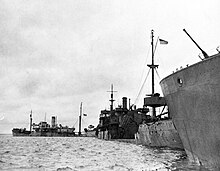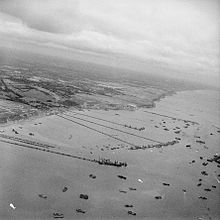
The Victory ship was a class of cargo ship produced in large numbers by North American shipyards during World War II to replace losses caused by German submarines. They were a more modern design compared to the earlier Liberty ship, were slightly larger and had more powerful steam turbine engines, giving higher speed to allow participation in high-speed convoys and make them more difficult targets for German U-boats. A total of 531 Victory ships were built in between 1944 and 1946.

Liberty ships were a class of cargo ship built in the United States during World War II under the Emergency Shipbuilding Program. Though British in concept, the design was adopted by the United States for its simple, low-cost construction. Mass-produced on an unprecedented scale, the Liberty ship came to symbolize U.S. wartime industrial output.

SS John W. Brown is a Liberty ship, one of two still operational and one of three preserved as museum ships. As a Liberty ship, she operated as a merchant ship of the United States Merchant Marine during World War II and later was a vocational high school training ship in New York City for many years. Now preserved, she is a museum ship and cruise ship berthed at Pier 13 in Baltimore Harbor in Maryland.

SS Martin Behrman was an American Liberty ship built in 1944 for service in World War II. Her namesake was Martin Behrman, long-time mayor of New Orleans, Louisiana. For the was she was operated by the Isbrandtsen Line under charter with the Maritime Commission and War Shipping Administration.
SS A. Mitchell Palmer (MCE-2436) was an EC2-S-C1 Type Liberty ship design cargo ship, named after U.S. Attorney General Alexander Mitchell Palmer. The ship's keel was laid by Southeastern Shipbuilding Corporation of Savannah, Georgia, on 17 December 1943, commissioned as part of the Second World War effort by the War Shipping Administration (WSA). It was launched 12 February 1944. It was scrapped in 1968 in Taiwan.

SS Timothy Bloodworth was a standard Liberty ship built for the United States Maritime Commission during World War II. The vessel was built by Delta Shipbuilding Company of New Orleans in 1943. She was named in honor of Timothy Bloodworth, an American teacher who made muskets and bayonets during the American Revolutionary War, then went on to become a statesman in North Carolina.

SS Samuel Huntington was an American liberty ship during World War II. She was the 248th liberty ship authorized by the United States Maritime Commission and was named in honor of Samuel Huntington, a Founding Father and signer of the American Declaration of Independence. SS Samuel Huntington was launched in 1942 and sailed to ports in the Pacific, South America, Africa, and the United Kingdom. She was one of a select group of liberty ships that were outfitted to carry a limited number of either troops or prisoners of war. As part of a convoy to resupply the Allied troops at Anzio, she sank after a successful German bomb attack in January 1944.
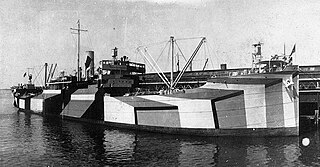
SS West Nohno was a cargo ship of the United States Shipping Board (USSB) launched shortly after the end of World War I. The ship was inspected by the United States Navy for possible use as USS West Nohno (ID-4029) but was neither taken into the Navy nor ever commissioned under that name.
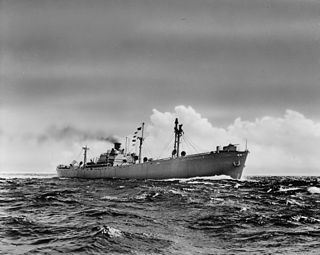
SS Marcus Daly was a liberty ship built by the Kaiser Shipyards at their Permanente No.1 yard at Richmond, California, and launched on 24 July 1943.
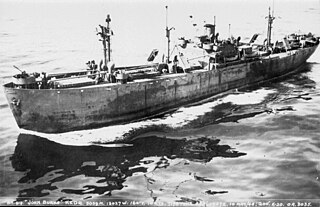
SS John Burke was an American Liberty Ship built during World War II, one of the 2,710 type 'EC2-S-C1' ships that carried all kinds and types of dry cargo during the war. The ship was named for John Burke, the 10th Governor of North Dakota. Burke was built at Kaiser Shipbuilding Company's Oregon Shipbuilding yard in Portland, Oregon. Burke's keel was laid November 20, 1942 and the hull was launched on December 13. After fitting-out, Burke was delivered to the US Maritime Commission on December 23, just 33 days after construction began. The War Shipping Administration then placed Burke under management of the Northland Transportation Company.

The SS Lawton B. Evans was an American military ship, constructed in Alabama during World War II it was named after the author Lawton Bryan Evans (1862–1934).

SS Frontenac Victory was a Victory ship built for the United States War Shipping Administration late in World War II under the Emergency Shipbuilding program. It saw service in the European Theater of Operations in the Atlantic Ocean during 1945, and in the immediate post-war period. SS Frontenac Victory was part of the series of Victory ships named after cities; this particular ship was named after the city of Frontenac, Missouri. It was a type VC2-S-AP2/WSAT cargo ship with the U.S. Maritime Commission (MARCOM), "Victory" (MCV) hull number 625, shipyard number 1597, and built by Bethlehem Shipbuilding Corporation in Baltimore, Maryland.

SS Elmira Victory was a Victory ship built during World War II under the Emergency Shipbuilding program. It was built and launched by the Oregon Shipbuilding Corporation on May 12, 1944 and completed on May 31, 1944. The ship's United States Maritime Commission designation was VC2-S-AP3 and hull number 105 (1021). The ship was Oregon Shipbuilding Corporation's 21st victory ship. The Maritime Commission turned it over for Merchant navy operation to a civilian contractor, the Isthmian Steamship Company under the United States Merchant Marine act for the War Shipping Administration. She was named after the city of Elmira, New York.

The SS Bucknell Victory was a Victory-class cargo ship built during World War II. The Bucknell Victory was a type VC2-S-AP2 victory ship built by Permanente Metals Corporation, Yard 2, of Richmond, California. The Maritime Administration cargo ship was the 728th ship built. Her keel was laid on December 27, 1944. SS Bucknell Victory was an armed cargo ship, named for Bucknell University in Pennsylvania, one of 150 educational institutions that had Victory ships named after them. She was built in just 70 days, under the Emergency Shipbuilding program for World War II. The 10,600-ton ship was constructed for the Maritime Commission.
SS Nathanael Greene was a Liberty ship built in the United States during World War II. She was named after Nathanael Greene, Continental Army general famous for his service in the Southern theater of the American Revolutionary War. She was operated by the United States Lines under charter with the Maritime Commission and War Shipping Administration.

SS Virginia Dare was a Liberty ship built in the United States during World War II. She was named after Virginia Dare, the first English child born in America, who disappeared along with the rest of the Roanoke Colony.

SS Hobart Baker was a Liberty ship built for the United States Maritime Commission during World War II. The ship was named in honor of Hobart Baker. Hobart "Hobey" Baker (1892–1918) was an American amateur athlete and is considered the first American star in ice hockey. He was also an American football player. The ship was assigned by the War Shipping Administration to General Steamship Company of San Francisco who operated it throughout World War II. Hobart Baker was laid down on 16 April 1943, launched on 12 May 1943 and completed on 24 May 1943, with the hull No. 1114 as part of the Emergency Shipbuilding Program, built is 38 days.

SS Skagway Victory was a Victory ship built for the United States during World War II. She was launched by the Oregon Shipbuilding Corporation on June 21, 1944, and was completed on July 15, 1944. The ship's US Maritime Commission designation was VC2-S-AP3, hull number 116 (V-116). She was built in 64 days under the Emergency Shipbuilding program. The Maritime Commission turned her over to a civilian contractor, the Alcoa, for operation until the end of World War II hostilities. She was operated under the US Merchant Marine Act for the War Shipping Administration.
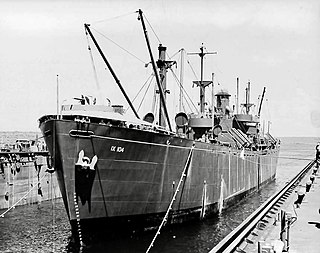
SS Peter H. Burnett was an American Liberty ship built in 1942 for service in World War II. She was later acquired by the United States Navy and renamed USS P.H. Burnett (IX-104). Her namesake was Peter Hardeman Burnett, an American Governor from 1849 to 1851.

World War II United States Merchant Navy was the largest civilian Navy in the world, which operated during World War II. With the United States fighting a world war in all the world oceans, the demand for cargo and fuel was very high. Cargo and fuel was needed around the world for the United States Navy, United States Army, United States Marine Corps, United States Army Air Forces, United States Coast Guard and the support of the allied nations of the United States. American steamship companies chartered ships from the Maritime Commission and War Shipping Administration to meet the demand. Many United States Merchant Marine ships were newly built in the Emergency Shipbuilding Program, other ships were older World War I ships that were put back in service, or private ships acquired under Emergency war requisitions. The Merchant Navy operated in the Pacific War and European war. Over 200 US Merchant ships took part in the D-day Normandy landings. To make a Normandy breakwater Harbor, called Mulberry harbour, 33 merchant ships were sunk 1,000 yards from shore. Some of the ghosts merchant ships used were damaged and others were deemed too old.

